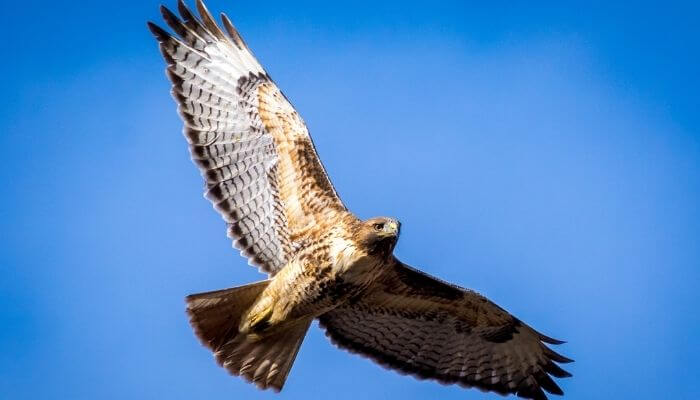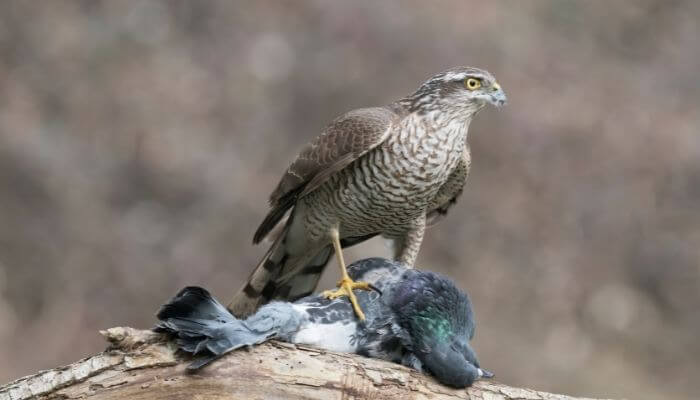Hawks are a bird of prey and yes, they do eat pigeons.
Birds of prey are natural predators of pigeons but pigeons aren’t the only live prey they eat.
How Common Are Hawk Attacks On Pigeons?
According to a government survey in response to pigeon owners voicing considerable concern about the increase in the number of birds of prey and the threat to their birds, it was found that 14% of “lost” pigeons was due to predation.
Bad weather, straying, collisions and domestic cats are greater threats.
Not only do pigeons have to be aware of the natural hunting process, but there are pest control companies in the UK that use specially trained hawks to catch pigeons where they are perceived by a customer to be a pest.
This trend added to the concern of pigeon owners and the increase in the number of predatory raptors in towns and cities.
It should also be noted that DEFRA doesn’t support this method of pigeon control and the organization of culling pigeons (and other wild birds) needs a license.
Different Types of Birds of Prey
There are two orders of birds of prey – Strigiformes and diurnal.
Strigiformes hunt at night and the order is comprised of all the different species of owl (split into Strigidae – typical owls and Tytonidae – barn and bay owls).
There are six types of diurnal birds of prey which are also known as raptors. The types may be a single type of bird or a family of similar birds.

These types are:
- Accipitridae: hawks, harriers, buzzards, eagles, kites and Old World (Europe, Asia and Africa) vultures
- Falconidae: falcons, forest falcons, kestrels and caracaras
- Pandionidae: the osprey
- Sagittariidae: the secretary bird
- Cathartidae: condors and other New World (the Americas and Australasia) vultures
- Cariamidae: seriemas (long-legged birds that live in Brazil, Argentina, Uruguay, Bolivia and Paraguay)
Owls hunt pigeons in a more opportunistic manner, mostly because owls hunt nocturnally and there are few pigeons about.
Pigeons, however, are aware that owls are a threat and owls in various structural forms are often deployed as decoys by people who want to keep pigeons away.
Sparrowhawks & Pigeons
In the UK, the main types of hawks which prey on pigeons are the sparrowhawk, goshawk and harrier hawks (hen harrier, Montagu’s harrier and marsh harrier).
Of these, the Montagu’s harrier is the rarest.
The sparrowhawk is the most common and widespread bird of prey in the UK and is also one of the most prolific hunters.
The average Sparrowhawk kills 110 pigeons a year!

Their hunting style is to adopt the element of surprise, usually waiting, hidden from view, to ambush their prey.
They will often swoop to attack and catch a pigeon feeding on the ground.
In short bursts, they can reach 50 kph but they employ hunting methods dependent on the habitat and prey. They prefer an area with a high probability of prey population as only one in ten attempts will result in a meal.
The goshawk is the largest of the UK hawks and has a fierce expression.
They live in forested areas but can still hunt at high speed, being able to use its broad wings to weave in and out of trees.
They also catch prey on the wing so pigeons in flight are threatened with the goshawk’s long legs and super sharp talons.
The harrier hawks fly lower than other hawks.
They glide low in search of prey and while pigeons are not their primary food, they won’t pass up the opportunity – especially fledglings and young birds.
How Do Pigeons Avoid Birds of Prey?
Pigeons are not easily scared.
They are also quite obstinate creatures.
If a sparrowhawk, for example, visits a favoured feeding area, the pigeons will probably only stay away from that area for a few hours.
They are also intelligent enough to know the warning calls that small birds make when a bird of prey is near.
That being said, there is little a pigeon on the ground can do about the speeding swoop of a hawk.
In flight, a pigeon also has little chance if it is targeted.
With the hawk’s speed comes surprise, so it is only if a pigeon gets an inkling an attack is imminent that they are able to try avoidance tactics.
This may include tumbling or rolling in mid-flight which makes it difficult for a hawk to get its trajectory of attack correct.
A racing pigeon may also be able to put on a burst of speed to take him away from those deadly talons.
How to Stop Hawk Attacks on Pigeons
If you are a pigeon owner or simply love to watch them when they visit your garden, you probably wish there were a way to protect them from becoming prey to hawks.
As a bird lover, you’ll be pleased to know that most forms of killing or trapping birds of prey are illegal in the UK (and many other countries).
For pigeon lovers and owners, that’s not such good news.
There are various ways to reduce the risk of your pigeons being the prey of hawks and other raptors. These include:
- Flying your pigeon(s) at different times of the day (hawks can detect a routine).
- Moving feeders to a sheltered spot.
- Keep your racing pigeons in optimum health so they remain fast in flight.
- Attract crows to your garden. Crows hate hawks and will harass them to drive them away.
- Use deterrents that hawks don’t like such as hawk balls, reflective objects on string (such as old CDs).
- Train your birds to return to the loft and not to make a pitstop on the ground in your garden.
It’s a shame to deter birds of prey because they are a magnificent sight either on a perch or in flight but as a pigeon lover/owner, the health of your pigeons and loft must come first.
